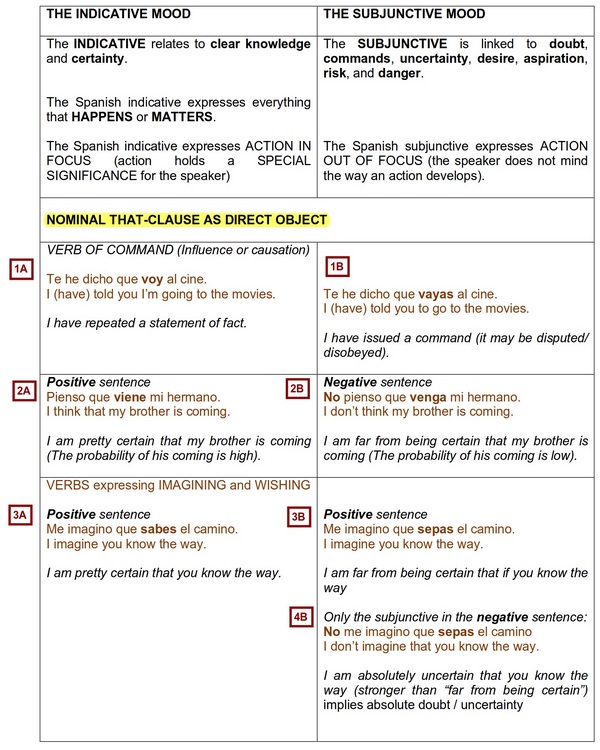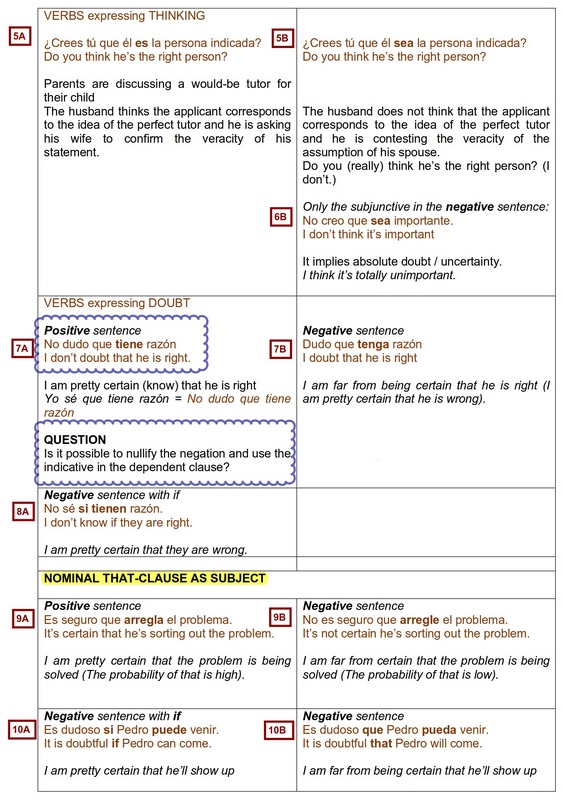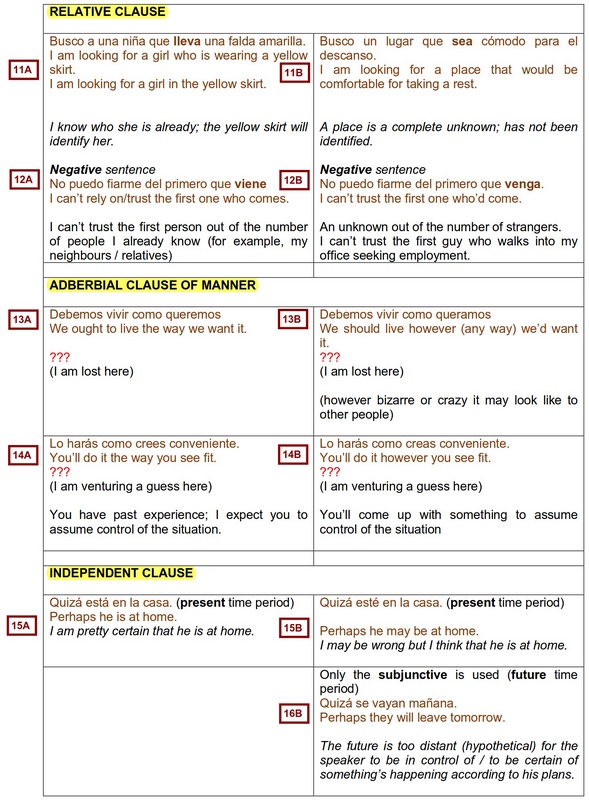Ask a Question(Create a thread) |
|
|||||||
Indirect and direct objects with esperarGrammar questions– conjugations, verb tenses, adverbs, adjectives, word order, syntax, etc. |
 |
|
|
Thread Tools |
|
Get rid of these ads by registering for a free Tomísimo account.
|
|
#2
|
||||
|
||||
|
I have to praise your instinct. There's something wrong there.
The original sentence in Spanish makes no sense to me. No sense at all. It looks like there's a period or semi-colon missing before que, as this is clearly not a conjunction between two parts. Les estamos esperando = We're waiting for them que el tren llegue a tiempo = may the train arrive on time We can force grammar to a bitter end and make that les a dativo de interés and translate the original sentence as "we're hoping for them to have their train arrived on time". In both languages the sentences sound low mid-class, second half of 19th century, or beginning of the 20th. Watching Twelve Years a Slave was the last time I heard something like that.
__________________
Sorry, no English spell-checker Last edited by aleCcowaN; February 17, 2025 at 08:13 AM. |
|
#3
|
||||
|
||||
|
You're being misguided by this text
Quote:
The Spanish verbal periphrasis "estar + gerundio" implies the action is currently happening. That is, the action has already started but it hasn't yet ended. And is strictly progressive, that is, it's used just as the action develops. So its use is more focused and narrow than its English equivalent. Number 3 makes some sense. 1, 4 and the example provided only make sense if somebody is asking "what's going on?" from the distance and someone with an electronic hearing device and a seer stone is answering them. 5 is non-sensical, as I've already said. And 2, well, "arse". Obviously, sone text recognition device was used to hang the text in the interwebs.
__________________
Sorry, no English spell-checker |
|
#4
|
||||
|
||||
|
Thank you. It is irse in sentence 2.
Te estoy sugiriendo que te vayas. I am suggesting (keep suggesting) to you that you leave/be off. I think that the author shouldn't be judged too harshly. She does her best to put her knowledge of the Spanish language across to her readers and if she bends/simplifies the grammar a little bit in order to place the material more accurately within the mental grid system of the English speaking students and help them digest material more easily, so be it. I agree with you that the sentences are far from being spot-on but, after all, the point is that the students get familiar with the concepts and, with this in mind, they'll make do. But mistakes are something totally different because they disrupt/mess up the student's cognitive process and, thus, absolutely inexcusable. Last edited by Nfqufktc; February 18, 2025 at 06:22 AM. |
|
#5
|
||||
|
||||
|
Spanish as She Is Spoke.
It's all so ill-formed you felt in the trap. [Nothing about leaving, then] Te sugiero que te vayas. [A lot of non confrontational hints about leaving, then, out of despair] (Lo que)Te estoy sugiriendo (es) que te vayas. The point is the author doesn't really know how the estar + gerundio periphrasis works in Spanish, so she should've had her texts proofread by someone who does before submitting them for publication. Your let's-not-be-harsh approach shows you don't perceive how awfully off and "un-Spanish" the example and most of the practise items are. The worst part, this excercise is part of an explanation of Spanish subjunctive that perpetuates the wrong notion of it not being used alone and always triggered or invoked by other part of the sentence in some ritualistic fashion, when wishes, hopes, expectations, and why not, PMS are involved. Really the CliffNotes, Letts and Lonsdale approach. No dejes que eso te confunda. (find indicative in the previous sentence)
__________________
Sorry, no English spell-checker |
|
#6
|
||||
|
||||
|
Thank you for your reply. I have been studying Spanish for less than a year from scratch and you are absolutely correct in that I am unable to perceive the nuances of, for example, using the estar + gerundio periphrastic form, though I must say that I have some ideas in this regard, but they are kind of vague and hard to be verbalized. But let me tell you that apart from this teach-yourself course, I also use a couple of university-level grammar manuals to get a broader understanding of the concepts introduced by the author. And I also extensively use Spanish-English dictionaries with examples to read and copy sentences. I also work on expanding my vocabulary.
My goal is to get a general understanding of the Spanish grammar (at elementary level) and build up a decent stock of words so I could start reading abridged books and then I will repeat the cycle (at intermediate level). What is the CliffNotes, Letts and Lonsdale approach? I tried to look it up, but without much of a success. CliffsNotes appear to be a series of student study guides. What is the alternative? As for you quiz question No dejes que eso te confunda Don’t allow that it would confuse you (Don’t let that baffle you). I would say it is formed in the imperative mood with the direct object as a clause having its verb in the present subjunctive (hypothetical situation: I may be confused / baffled or may be not). Last edited by Nfqufktc; February 19, 2025 at 08:34 AM. |
|
#7
|
||||
|
||||
|
Your comprensión in Spanish is really high, so, congratulations. In a 10-level complete course you seem to be in level 6 or so.
By a CliffNotes approach (Letts and Lonsdale are their British countreparts; Resúmenes Lerú in Argentina) I mean the kind of shortcut that gives you the right answer 80% of the times without you really learning anything, like "expectations trigger subjunctive" so "I hope he comes" becomes "Espero que venga" and, voilà! Sometimes, I must admit, it's the only way to start the topic. The comprehensive way is difficult, the strange thing in Spanish isn't subjunctive but its indicative. Spanish indicative really demands action, an I leave it there by now. Spanish subjunctive demands, or at least suggests, inaction. So, you have Go! ---- ¡Ve! Don't go! --- ¡No vayas! ( not ¡No ve!  ) )As there are luckily only two of them, we have to manage with indicative for everything that happens or matters, and use subjunctive for everything else. Subjunctive is like the piano's left pedal or the trombone mute: it defocuses the action leaving the limelights for the action carried out in indicative. Let's apply it Yo espero (es MI voluntad y está ocurriendo ahora)/el viene (o no, porque es SU voluntad y además no está ocurriendo ahora) then Espero (focused) que venga (defocused) It looks so difficult, doesn't it? Well, only the first 5 or 10 times, then it's swish. Finally a battle between the CliffNotes approach and the real deal. Quizá triggers subjunctive A lo mejor triggers indicative -Me compré un billete de lotería -Es una posibilidad en 43000, pero quizá te la ganes. -Sí, es una posibilidad en 43000, pero ¡a lo mejor me la gano!. According to good Cliff, both said exactly the same. Not quite. First person: it's improbable, so subjunctive. Second person: I couldn't care less. I have my hope this is the winner ticket, and that will continue to be the only relevant posibility for me until the result proves me wrong. A lo mejor me la gano. It has become focused because it has a special significance for me, not because of the chances. Here hope triggered indicative. Take that, Cliff, and your cousins Letts and Lonsdale!
__________________
Sorry, no English spell-checker |
|
#8
|
||||
|
||||
|
¡Hola!
Thank you for sharing your knowledge with me. Your explanation has given me a whole new perspective on the subject of the subjunctive. I have just one question: Is the conjunctive word que obligatory in the indicative sentence or it can be put in at will? I have looked up the examples in my dictionaries but unfortunately ALL the examples in ALL the dictionaries are in the subjunctive. Not a single one is in the indicative. On the other hand, all the sentences with esperar in the subjunctive are formed with que. I would appreciate it if you could advise on the accepted norm. May I request that you review a set of example items that I have compiled (same sentence in the indicative and the subjunctive), each item with a short note of how I would justify the use of the particular mood? I would appreciate it if you could pass your judgment on my understanding of the use of the moods in the sentences. Thank you.   
Last edited by Nfqufktc; February 21, 2025 at 08:21 AM. |
|
#9
|
||||
|
||||
|
As Jack the Ripper said, let's go part by part
 2A and 3A deal with creer, pensar, imaginar, all verbs that imply a notion is alive and kicking in the speaker's mind, therefore indicative. 2B, 3B and 4B deal with either the lack of a notion or the presence of a notion that deems the action inactive or void. In the first case, subjunctive (case 2B and 4B), in the other, indicative (3B) which then becomes 4B. As it is presented 3B is agramatical, that is, it makes no sense. Me imagino que sabes el camino. Me imagino que no sabes el camino. notions in my mind = indicative No me imagino que sepas el camino. No me imagino que no sepas el camino. notions not in my mind = subjunctine However, brace yourself. The following is not intended to complete a set of rules you should know soon, but as a warning about what every student bumps into sooner or later. Phrases like No imagino que sabes el camino. No imagino que no sabes el camino. are now and then possible and right, but the matter here is the meaning of the verbs and not the grammar behind I could translate them as I can't conceive you know the way. I'm really skeptic about it. I can't conceive you don't know the way. I suspect foul play here. Watch how rutinary, run of the mill, everyday, "it's not in my mind then subjunctive", become, exceptionally, very focused. "You're saying the notion shouldn't be in my mind, but I'm having a hard time believing it, so a ghost indicative". Maybe I should have kept my big mouth shut, but it's important to consider the meaning of a verb can change and the selected mood be what's hinting it. I promise to address the other examples soon.
__________________
Sorry, no English spell-checker |
|
#10
|
||||
|
||||
|
It's difficult to deal with the examples as you laid them out.
Quizá está en la casa (Best guess ----> more focused) Quizá esté en la casa (conjecture, just a guess --->less focused) Quizás se vayan mañana (conjecture, just a guess --->less focused) Quizás se van mañana (informed guess, maybe through hints ----> more focused) A lo mejor se van mañana (conjecture, just a guess, but be us that fortunate --->more focused)
__________________
Sorry, no English spell-checker |
|
#11
|
||||
|
||||
|
Busco a alguien que habla inglés (I may not know who that is but It is my understanding such person exists; or maybe I know them but I didn't catch their name)
Busco alguien que hable inglés (I don't know that person; I don't even know if such a person exists) Busco un lugar donde se pueda hacer un pícnic. Busco el lugar donde se puede hacer un pícnic. Por favor, indíqueme si hay un lugar donde se pueda hacer un pícnic. Por favor, indíqueme cómo llegar a uno de los lugares donde se puede hacer un pícnic.
__________________
Sorry, no English spell-checker |
|
#12
|
||||
|
||||
|
No creo que sea importante
I don't think it's important Creo que no es importante I think it is unimportant Again, the notion is/isn't in the speaker's mind Outlier: No creo que es importante I don't believe those who say it is important. I don't believe it to be important.
__________________
Sorry, no English spell-checker |
|
#13
|
||||
|
||||
|
Quote:
I always compare It to changing gears in old automobiles using the clutch pedal. Que is the pedal. It softens the change and avoid those horrible noises of gear teeth reaching a breaking point. Suposse I say Quiero vengas. It's difficult to parse as everything colides, but que lubricantes the sentence and allows to parse it easily Quiero que vengas. That said, it may be suppressed colloquially no matter what mood is involved: No me digas vas a entregar eso así ¡Es un mamarracho! Te pido te comportes como un caballero. Confío te dieron tu merecido. Ningún mal dura cien años, pero ciertos males tiñen canas ( hay and que suppressed)
__________________
Sorry, no English spell-checker |
|
#15
|
||||
|
||||
|
You're quite welcome!
 I'll continue later with the other half of your examples I haven't analised yet, but I want to comment you seem to be doing what almost all students do regarding Spanish subjunctive, placing too much importance in the probability aspect (1) and compiling an ever growing list of examples in any possible situation, a never ending task as exceptions and counterexamples continue to pile up to no end. My reflexion has always been: two moods, 17 examples; two moods, 156 examples; two moods, 934 examples...nobody sees what's wrong in that picture? The matter is just how that couple of states of mind interact and not the gazillion pret-a-porter solutions. Learning Spanish subjunctive has three stages you don't have the faintest idea what you're doing you don't know what you're doing you know what you're doing A good book on the subject shouldn't contain incomplete phrases in Spanish as its goal but a long list of phrases in a foreign language to translate into Spanish and a card to keep record of the student's hits and fails. No matter what, if he comes and brings no money, no matter the excuses he gives, hand him the eviction notice. This is a tough one . If you translate it this week as "te da" and next week as "te dé" and keep changing week after week, that's the faintest idea stage. If you choose permanently one of them, you are in stage 2 or 3. An English speaker tends to choose "te da" because English is an assertive language, and the situation in the example is harsh and one to be handled in a heartless way. But that would be a wrong use of "focus" as I meant while explaining this topic. The better answer is "te dé" and that doesn't make the phrase less harsh in Spanish, it only reflects the excuse is yet unknown and not the main subject in the phrase. Subjunctive doesn't imply here that certain excuses may be at all accepted. If the tenant shows up crying while holding the corpse of his daughter in his arms, I'm sure the eviction will be much delayed, and that's not because subjunctive has been chosen (1) English sometimes manages likelihood better than Spanish, with can-may-could-might or can-could-may-might depending on the side of the Atlantic you want to be stranded on.
__________________
Sorry, no English spell-checker |
|
#16
|
||||
|
||||
|
¡Hola!
I have just read a text about a little girl who is going on a candy collecting trip with her girlfriends in her neighborhood on the evening of Halloween. Her parents are concerned but they let her go. The text is followed by some comprehension checking questions and one of them goes like that: ¿Piensa Ud. que ellas van a regresar? My answer was Claro que ellas van a regresar. Nada va a ocurrirlas. = Nada las va a ocurrir. = Nothing is going to happen to them. (notion is alive and kicking in my head) The assertion is that the neighborhood is safe = the indicative. But if I thought that if they were likely to be snatched by a maniac, I could have used Pienso que ellas vayan a regresar. I would appreciate it if you could comment on my line of reasoning. Thank you. |
|
#17
|
||||
|
||||
|
Nada va a ocurrirles
Nada les va a ocurrir. Pienso que ellas van a regresar. Pienso que ellas no van a regresar. No pienso que ellas vayan a regresar. No pienso que ellas no vayan a regresar. The question is in my mind/not in my mind and not alive an kicking, which in the end is applied here to pensar. Refer to posts #9 and #12 in this thread. I will complete all the examples in your table this week. My previous post contains the key about why students make these mistakes. It's a matter of "scope". Creer and its here synonym pensar show the outcome of your brain's cogs turning and producing a final picture (van/no van a regresar) or failing to do so by returning an empty frame (no pienso). Vayan informs via subjunctive what picture the frame failed to contain.
__________________
Sorry, no English spell-checker |
|
#19
|
||||
|
||||
|
I'm sorry for the delay.
1A and 1B Te he dicho que voy al cine. Voy al cine. Te lo he dicho. Voy al cine (present meaning a scheduled future event, not certitude). Te lo he dicho. (lo, the previous bit of información) The conjunction que allows here both sentences to become one. Te he dicho "ve al cine", pero tú no me haces nunca caso (imperative, no matter probability reaching 0). Pero hoy vas al cine, porque yo te lo digo, y sanseacabó. Pero hoy vas (present as a future scheduled event, working as an imperative) al cine, porque yo te lo digo y sanseacabó. Te he dicho que vayas al cine. Here, ir is defocused to avoid competition with decir. Reinforced by it's known información. Likelihood doesn't matter.
__________________
Sorry, no English spell-checker |
 |
| Tags |
| modo, mood, subjunctive, subjuntivo |
«
Previous Thread
|
Next Thread
»
| Link to this thread | |
| Thread Tools | |
|
|
|||||||
 Similar Threads
Similar Threads
|
||||
| Thread | Thread Starter | Forum | Replies | Last Post |
| Direct and Indirect Objects in the Spanish Sentence | Nfqufktc | Grammar | 9 | April 10, 2024 10:43 PM |
| Pronouns - direct and indirect objects | wattspamela31 | Practice & Homework | 2 | February 29, 2012 12:19 PM |
| Identifying the direct and indirect objects | pia | Practice & Homework | 7 | April 12, 2011 08:21 PM |
| Direct and Indirect Objects Word Order | FrannyCakes | Grammar | 6 | July 11, 2009 05:27 PM |
| Tenses, Direct and Indirect Objects, Articles, Oh My! | AutumnBreeze | Teaching and Learning Techniques | 22 | June 16, 2009 01:14 PM |
All times are GMT -6. The time now is 05:19 PM.










